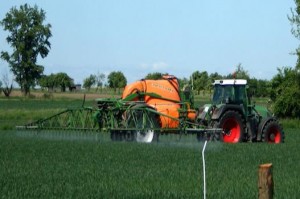Anja Knäbel reports about their recent paper “Aquatic exposure predictions of insecticide field concentrations using a multimedia mass-balance model”.

Up to now, in the EU the concentrations of pesticides from agricultural use in surface waters have been predicted using the FOCUS model (photo by R. Bereswill)
Plant protection products can be approved in Europe only when the predicted concentrations in surface waters are below the ecologically critical threshold value. Since the end of the 1990s the EU employs the so-called FOCUS modelling approach for the calculation of the expected discharge of pesticides from agricultural use to surface waters. This approach is required by law for the approval process, but it was shown before that the modelling approach is not suitable for predicting actual measured pesticide concentrations.
In this study we compared 466 concentrations of insecticides measured in European surface waters with the concentrations predicted by the FOCUS models and determined the number of concentrations which the respective model underestimated. In addition to the FOCUS modelling approach, the study also examined a simpler box model, which ultimately gave the better results.
The difference between the two models lies in the nature of the two modelling approaches. The FOCUS approach derives from different mechanistic models, based upon different detailed processes. In other words, the model attempts to exactly describe the whereabouts of a pesticide following its application. On the other hand, the box model examined in the present study provides a very general description of the distribution between the different environmental compartments. It calculates the tendencies of a chemical, in this case a pesticide, to migrate from one compartment to another, for example from the soil to the atmosphere, on the basis of only a few substance properties.
The new study compares this simple box model, requiring only a few input values, and the relatively complex, non-transparent FOCUS model in respect of two essential modelling properties: first, the level of protection which the model describes in a environmental risk assessment and second, the predictive quality, in other words how well the predicted and actual pesticide contamination of surface waters compare.
Our recent study shows that the application of a much simpler model yields far more reliable results and furthermore appears to exhibit better predictive quality when it is adapted to the particular field situation.
However, underestimating the actual concentration in the environment can lead to a miscalculation of the environmental risk. With this study, we would like to give cause for thought and concrete courses of action for a revision of the pesticide risk assessment procedure employed until now in the EU.
The paper was authored by Anja Knäbel, Martin Scheringer, Sebastian Stehle, and Ralf Schulz and is published in Environmental Science & Technology.
Liked this post? You may also be interesetd in: Neglected Risks – Erosion Rills Compromise Regulatory Pesticide Exposure Assessment
